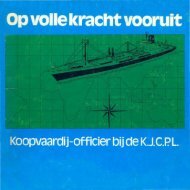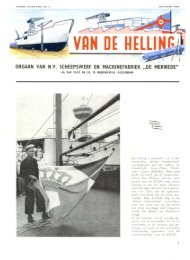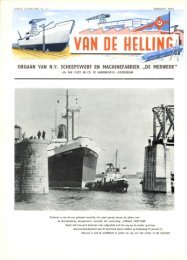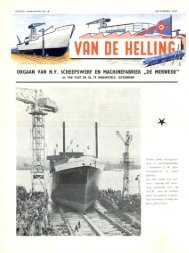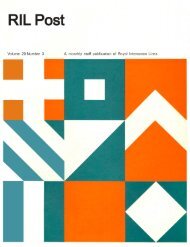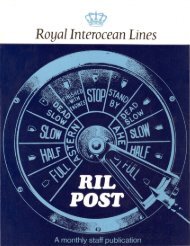You also want an ePaper? Increase the reach of your titles
YUMPU automatically turns print PDFs into web optimized ePapers that Google loves.
<strong>RILPost</strong><br />
Volume 21 Number 7 A monthly staff publication of Royal lnterocean Lines
.( (<br />
... .,1, .:..".<br />
At Rijswijk: The guests of honour arrive. From left to right Mrs van der Schalk, Mr L.P. Ruys,<br />
Mr H.M. van der Schalk and Mrs Ruys followed by Miss Mooiweer and Mr B. Scheffer.<br />
FARE WELL RECEPTIONS IN THE NETHERLANDS<br />
Two receptions were held in the Netherlands to enable Messrs L.P. Ruys and H.M. van der<br />
Schalk to say goodbye to their staff and business friends. The first reception was held at Oud<br />
Wassenaar on 29th May and was attended by business relations of the NSU. The reception for<br />
staff was held at Rijswijk on 31st May.<br />
At Wassenaar: Was chartering ships the subject? Mr Whitehead (centre) declines to answer<br />
that question. Left Mr F. Terwogt and right Mr H.G.G.L. Ribbink.<br />
122
At Wassenaar: Mr Martin Schroder (centre) and Mr B. Scheffer (far right) have an eye for beauty!<br />
As Mr and Mrs van der Schalk<br />
and Mr and Mrs Ruys entered<br />
the reception room of the<br />
NSU-Building at Rijswijk on<br />
31st May, those present started<br />
a gay, " For they are jolly<br />
good fellows" (whereby the<br />
line: " and so say all of us"<br />
was adapted to, "and Ruys<br />
and van der Schalk").<br />
Speakers were Mr B. Scheffer,<br />
Chairman of the Executive<br />
Board, Miss J . Campagne<br />
Mr Ru ys' secretary, Miss M .<br />
Mooiweer for many years the<br />
secretary of Mr van der Schalk<br />
(both ladies presented the<br />
staff's farewell gifts) , and finally<br />
Mr M .A. Beels and Mr<br />
H.C.G.L. Ribbink who each<br />
presented a scrapbook containing<br />
remembrances of the<br />
long and outstanding careers<br />
of M essrs Ruys and van der<br />
Schalk. (See page 135) .<br />
After the guests of honour<br />
had replied, hundreds of NSU<br />
At Rijswijk: Mr de Jong (Quick Despatch) brought a present<br />
for Mr Ruys. Mr and Mrs van der Schalk are happily chatting<br />
with their guests further along the receiving line.<br />
personnel from Rijswijk, Amsterdam<br />
and Rotterdam and<br />
pensioners from all over the<br />
country lined up to pay their<br />
respects and for a final handshake.<br />
123
The aim is to keep the pigeon holes as empty as possible,<br />
a sign that all the ship's mail has been delivered to the<br />
Post Office.<br />
POSTBOX 2000<br />
Postbox 2000 is a concept w hich is fast becoming familiar<br />
to AIL seagoing staff and t heir families. It is the NSU 's<br />
new centralised system for forwarding mail to seafarers.<br />
First used by Nedlloyd, since 1st May AIL and HBT have<br />
also been using the new system. The department, 'Tending<br />
of mail for seafarers" which operates Postbox 2000<br />
is located at the Personnel Department of the NSU in<br />
Rotterdam. Here a special RIL desk has been set up. To<br />
make you more famil ia r with t he new system w e introduce<br />
some of t he staff w ho work in the department and<br />
operate the AIL desk. T he staff t eam itself is a true NSU<br />
integration, headed by Mr H.H. Bonke ( formerl y KR L)<br />
who is assisted by Mr J .G.J. van Midden (formerly VNS)<br />
and Mr R. Bakker (formerl y SMN).<br />
Many people have asked, w hat is t he purpose of Postbox<br />
2000. The purpose is to ensure that mail reaches its<br />
destination quicker t han before. In the past, mail ch its<br />
were forwarded by the personnel department to relatives<br />
of seagoing staff to keep t hem informed of t he latest<br />
ship's movements and to tell them where to forward<br />
their mail. Recently, due to the increasing number of<br />
changes in the ships' sailing schedules, often at short<br />
notice, mailchits were continually having to be corrected.<br />
This led to delays in t heir despatch and naturally t here<br />
w ere complaints. Under t he new system, relatives send<br />
t heir mail to Postbox 2000 where the staff can react<br />
immediately to changes in sa iling schedules and forward<br />
the mail accordingly. Relatives of RIL seagoing staff have<br />
already been sent details of how Postbox 2000 operates,<br />
of the postal charges for the five airmail zones worldwide<br />
124<br />
The RIL desk with Mr F.P.H. Heltzel (far left) in charge.<br />
From left to right are Miss Elly van Rutter and Mr D .<br />
Bains. On the far left Miss Wil Vermeulen gives departing<br />
instructions to two new apprentice officers (coincidentally<br />
brothers) Messrs J.A. and F.C. de Roo.<br />
and the regulations for despatch of "oral" letters in t he<br />
form of cassettes and tapes.<br />
This is how the system works. The sender addresses his<br />
letter to:-<br />
Name and rank of seafarer.<br />
Name of ship,<br />
Postbox 2000<br />
cjo NSU Scheepvaart,<br />
Rotterdam 3005.<br />
Letters t hus addressed and bearing sufficient postage to<br />
reach their destination will be sent out immediately. It is<br />
NOT necessary to forward these letters to Postbox 2000<br />
in a separate cover provided w ith additional postage<br />
stamps. Aerograms, letters and "oral " letters in the form<br />
of cassettes and tapes can be sent by Postbox 2000, but<br />
NOT parcels. newspapers or magazines.<br />
Instant informat ion about despatch of mail m ay be obtained<br />
by ringing t he new department at No. 010-36.66.00<br />
between 9.00 and 16.00 hours Monday to Friday.<br />
In addition eight automatic telephone advisory devices<br />
w ill soon be in use. By dialling the relevant number you<br />
can get the very latest information about each ship's<br />
position. Relatives of seagoing staff w ill be informed of<br />
t he relevant telephone numbers as soon as possible.
... ....:::;...,<br />
From left to right Mr R. Bakker, Mr J .G.J . van Midden<br />
sorting out the mail, and Mr H .H. Bonke head of the<br />
Postbox 2000 team. The pigeon holes on the right are<br />
for RIL vessels.<br />
SERVICE ANNIVERSARIES<br />
Mr W . Kroesen: First Assistant Filing Dept. Amsterdam.<br />
entered KPM service on 18-5-49.<br />
A popular man with the ladies, Mr L.F. Brinkman Visser<br />
is in charge of passage affairs for RIL's Captains and<br />
Officers and keeps RIL wives informed of their husbands<br />
flight arrival details.<br />
The complete Filing Department of former days attended Mr<br />
Kroesen's jubilee celebration and posed for this photo. From<br />
left to right are: seated/kneeling, Mr R.A. Jager, Mr W. Kroesen,<br />
Mr J. Hoogendoorn, Mrs Kroesen and Mr P.H. Lasschuit; Standing,<br />
Mr M . Klerk, Mr A.N. Koopman, Miss M .G.E. Kroon, Miss C.V.<br />
van Merkom, Mrs H.C. Menage-Assendelft, Mr H.E. Meyer, Mr Mr S. Mohd. Husein bin Shariff: Filing Clerk Penang .<br />
J .N . Korstyn and Mr R. Romswinckel. entered RIL service on 1-6-47.<br />
125
SEDCO 135F-a forerunner of things to come at the Maui field.<br />
New Zealand's Maui gas field, located<br />
off Taranaki on the east coast of the<br />
North <strong>Is</strong>land, is one of the b iggest<br />
natural gas fields in the world with<br />
recoverable reserves estimated at<br />
between four and six billion cu. ft.<br />
In July 1973 the Government signed<br />
an agreement w ith the Sheii-BP-Todd<br />
consortium to jointly develop the<br />
Maui gas field. The development<br />
scheme will be one of the largest<br />
construction and engineering projects<br />
ever undertaken in New Zealand.<br />
Supplies from Maui will be used to<br />
fuel four new power stations which<br />
together will produce as much electricity<br />
as t he country used during<br />
the past year. The o rigin al estimated<br />
cost of tapping the gas field and<br />
distributing supplies was $263.6<br />
million but this has already been<br />
increased due to inflation.<br />
The Maui story started in 1965, when<br />
the New Zealand Government enacted<br />
legislation to control off-shore mineral<br />
exploration and development. Sheii<br />
BP-Todd started reconnaissance off<br />
the Taranaki coast early in 1966. In<br />
126<br />
March 1969, production testing at<br />
the first well, Maui I, disclosed the<br />
presence of crude oil, natural gas<br />
and associated condensate. In order<br />
to assess the commercial potential<br />
of this find, a semi-submersible drilling<br />
rig had to be used. In Canada,<br />
Shell were about to release SED CO<br />
135F and this rig w as towed to New<br />
Zealand at a cost of £2t million. The<br />
tow took four months to complete<br />
as t he rig could only travel at a<br />
maximum speed of 3 knots. In the<br />
following 15 months SEDCO drilled<br />
many exploratory well s in scattered<br />
sites all around the coasts of New<br />
Zealand, amongst them Maui II, Ill<br />
and IV. By July 1970, it became clear<br />
that gas had been discovered at<br />
Maui in vast commercially-productive<br />
quantities.<br />
Development of t he Maui field will<br />
take place in two stages. The first<br />
stage, scheduled for completion in<br />
1978, involves the installation of a<br />
three-deck drilling platform at the<br />
Maui Ill location. off Opunake, with<br />
a potential gas delivery capacity of<br />
600 million cu . ft. a day. It also in-<br />
DEVELOPING<br />
NEW ZEALAND'S<br />
MAUl<br />
GAS FIELD<br />
volves t he construction of a 24 inch<br />
diameter off-shore gas pipeline and<br />
a 10 inch condensate pipeline. The<br />
second stage, scheduled for 1979-83,<br />
is likely to consist of a s ingle platform<br />
structure at the Maui I location<br />
with a gas delivery capacity of 300<br />
million cu. ft. a day. Here there would<br />
be a 20 inch off-shore gas pipeline<br />
and a 10 inch condensate pipeline.<br />
A very much larger semi-submersible<br />
drilling rig, Penrod 74, now in<br />
the final stages of construction in<br />
Singapore, w ill be making the 45 day<br />
tow to Taranaki Bight in July (see<br />
page 128) . In recent months extensive<br />
off-shore seismic surveys have<br />
been made in a number of concessions,<br />
obviously w ith an eye to using<br />
Penrod while it is in New Zealand<br />
waters. Penrod 74 will drill at least<br />
6 exploratory wells in t hree concessions<br />
off the coasts of New Zealand,<br />
including at least one exploratory<br />
well in a new structure associated<br />
with the Maui field. Exploration by<br />
Penrod could continue for up to two<br />
years and if results are good there<br />
will be an oil boom for New Zealand.
A lthough Maui is a deep-water<br />
operation, developments under way<br />
in the North Sea involve coping with<br />
greater depths. The average water<br />
de pth in the North Sea's Brent field<br />
for example is 475 ft . compared<br />
w ith 360 ft. in the M au i field. Th e<br />
significant difference between Maui<br />
and most other sites is its location<br />
in an ea rthquake zone, a factor that<br />
has dictated special research into<br />
the stru ctural design of the drilling<br />
platform to be installed. The platform<br />
w ill be located on a soft silt seabed<br />
and will have to sustain storm conditions<br />
w hich might include w inds<br />
of up to 163 m.p.h. and storm waves<br />
of 73 ft. high. The large diameter of<br />
t he gas pipeline and t he remoteness<br />
of M aui from other areas w ith similar<br />
operations also add to the complexity<br />
of t he scheme.<br />
The quest for oil in New Zealand<br />
began in 1866 w ith the sinking of<br />
the Alpha Well rig ht on the waterfront<br />
at New Plymouth. There was<br />
great excitement when, at a depth<br />
of 20 ft. gas began to discharge so<br />
violently that a special wind sail had<br />
to be erected to divert fresh air to<br />
t he nearly asphyxiated diggers. But<br />
neither this well, nor the other two<br />
sunk nearby, became big producers<br />
although A lpha yie lded up to 80<br />
gallons a day at one stage in 1866.<br />
This was only seven yea rs aft er the<br />
discovery of the world's fi rst com <br />
mercial oilfield at Titusville USA.<br />
In 1959, an underground gas condensate<br />
field was discovered at<br />
Kapuni in Taranaki Province. Condensate<br />
from both Kapuni and the<br />
Maui separation plant at Oaonui w ill<br />
be piped to holdingt anks at New<br />
Plymouth's Port Taranaki and shipped<br />
by tankers to t he Marsden Oil<br />
Refi neries. Port developments at<br />
Port Taranaki will include the leasing<br />
of bert hs for pipebarges, supply and<br />
service tugs, storage areas and<br />
adjacent buildings to Shell BP Todd<br />
Service. Large areas of land adjacent<br />
to Blyde W harf have been c leared<br />
and levelled as storage and assembling<br />
poin ts for pipes and equipment<br />
and for helicopter pads. The<br />
influx of tugs, barges and service<br />
vessels is expected within t he next<br />
twelve months.<br />
PENROD 74 is 255ft. long, 191 ft. wide and towers t o a height of 128 feet from base to upper hull deck. The entire structure incorporat es<br />
some 11,000 tons of st eel and has taken not less than 2 million man-hours to build.<br />
A semi-submersible rig like Penrod'74 belongs to a class of sophisticated offshore drilling rigs designed to operate in severe weather<br />
and sea conditions. Basically it consists of an upper hull (platform) supported by a number of vertical columns which are j oined at<br />
the base to parallel lower hulls and cross beams. The latter are submerged in water and together with the columns provide buoyancy<br />
f or the whole unit. The upper hull accommodat es quarters, controls, cranes, derrick and drilling equipment et c .<br />
127
l -<br />
128<br />
I<br />
PENROD 74<br />
During the construction of Penrod<br />
74 in Singapore, a historic joining<br />
operation took place last December,<br />
five miles at sea near the southern<br />
isle of Pulau Sebarok. No operation<br />
of this kind has previously been<br />
performed outside the USA and<br />
(very recently) Spain, and it was a<br />
considerable achievement for Singapore's<br />
Far East Levingston Shipyard.<br />
The problem was how to place the<br />
upper hull on top of the columns.<br />
It was impossible to lift it into position<br />
due to its tremendous weight,<br />
4,000 tons. The method employed<br />
was to sink the lower section, float<br />
the upper hull over its top, and then<br />
raise t he whole structure by deballasting.<br />
T he combined lower hulls/columns<br />
and the upper hull were towed<br />
separately to the site about 15 miles<br />
from the shipyard. The site was<br />
chosen for its depth of 25 fathoms<br />
w ith a manoeuverin g radiu s of 1500<br />
feet away from sea traffic. T he lower<br />
section was sunk by flooding until<br />
only 12 feet of the columns stood<br />
above the sea surface. Then t he<br />
upper hull, resting on a huge pontoon<br />
was gradually floated across the tops<br />
of t he columns. At t he critical point<br />
of alignment, the lower section was<br />
raised to slot into the upper hull and<br />
welded on. There was a tiny clearance<br />
of only 3 inches for the pontoon<br />
carrying the upper hull to slot in<br />
between the tops of the columns,<br />
b:"Jttling against a choppy sea w ith<br />
swift currents. Clearly the operat:on<br />
was a tremendous achievement in<br />
terms of delicate engineering man-<br />
3 oeuvers.<br />
Shipyard personnel had made elaborate<br />
preparations for this exciting<br />
project. Some 200 men on 2 shifts<br />
worked on t he rig at the sea location<br />
in addition to the details of transportat<br />
ion, accommodation, food, supplies,<br />
equipment power, communications,<br />
safety, emergency arra ngements and<br />
insurance which had to be w orked<br />
out.<br />
l ower hull and columns being towed<br />
out to sea for the joining operation.<br />
2 l ower hull and columns being sunk to<br />
110 ft depth by Electronic Ballasting<br />
Control.<br />
3 Upper hull being positioned over the<br />
columns.<br />
4 l ower section was raised t o slot into<br />
4 the upper hull and welded on.
Tai Ki moored at Aplichau; notice the leeboards attached t o the side of the hull.<br />
Whistling for a Weste rly Wi nd<br />
In mid June, eight men in Hong Kong<br />
were patiently waiting for a south<br />
westerly wind to set out on an epic<br />
s ix month voyage across the Pacific.<br />
Their vessel, moored at Aplichau, is<br />
a junk called Tai Ki. This is no ordinary<br />
junk. In every detail of its<br />
design it is an exact replica of a tiny<br />
clay model junk found in a tomb nea r<br />
Canton dating from the Han Dynasty<br />
206 BC-220 AD.<br />
Project Tai Ki Pacific is the culmination<br />
of several years of research on<br />
t he part of skipper, Carl Grage and<br />
other members of the Tai Ki team.<br />
(See RIL Post September 1973).<br />
The project w ill attempt to prove<br />
that the Olnec and Chevin t ribes<br />
of Central America were descended<br />
from Chinese of the Han Dynasty<br />
who t ravelled across t he Pacific in<br />
junks made of pine and camphor<br />
wood with sa il s of bamboo matting.<br />
Archeologica l evidence for this theory<br />
has been found in Central America<br />
and Mexico; pottery and sculpture<br />
unearthed display symbols and lettering<br />
remarkably similar to Chinese<br />
work of the Han period. However<br />
evidence that Chinese of the Han<br />
Dynasty ever sailed on the open<br />
ocean has proved difficult to find.<br />
130<br />
The vital clue was Carl Grage's<br />
discovery that Han sa ilors used a<br />
constellation of 28 stars, proof that<br />
they travelled far from t he coasts of<br />
China.<br />
Tai Ki was originally scheduled to<br />
leave Hong Kong on 25th M ay. With<br />
only a single rattan square sa il she<br />
ca nnot beat t he w ind and t hus it is<br />
imperative t hat she leave soon after<br />
this date in order to make maximum<br />
use of certain w inds and currents.<br />
She w ill sail north to latitude 40°<br />
or 50° where a strong wind from<br />
northeast China converges w it h<br />
w inds blowing up from the South<br />
Pacific. Carl Grage hopes to maximise<br />
the effect of these w inds with<br />
a strong current w hich runs for<br />
only a short duration each year. T he<br />
current should ca rry Tai Ki across<br />
the Pacific north of Hawaii to the<br />
California coast and t hen south to<br />
the Bay of Tehuantepec at the<br />
southernmost tip of M exico.<br />
It has taken 200 days to build the<br />
58 ft. Tai Ki as opposed to 60 or so<br />
for a modern junk. Only Chinese fi r<br />
could be used for the planking w ith<br />
bilian and teak for the frame and<br />
beams. It took four months just to<br />
locate suitable pieces of timber for<br />
The mast looks strong, but in ca<br />
spare on board.<br />
the mast and spare mast. Ch inese fir<br />
is not easy to bend and the workmen<br />
used no mechanical tools except an<br />
electric drill to bore ho les.<br />
The junk is held together by 300<br />
wooden dowels; not a single nail or<br />
screw has been used. The dowels<br />
are made from a special hardwood<br />
which comes from the lychee tree;<br />
four such trees were purchased from<br />
the New Territories to make the<br />
dowels. Many of t he dowels broke<br />
when first inserted and often several<br />
attempts were necessary before t he<br />
craftsmen achieved a secure fit.<br />
Wherever possible the dowels were<br />
left protruding so that should they<br />
work loose, it w ill be possible to<br />
split t hem and drive in a wooden<br />
wedge.<br />
The series of bamboo huts, w hich<br />
form the superstructure and living<br />
area, also posed problems and had<br />
to be reassembled many times to<br />
strike a ba lance between authenticity<br />
and seaworthiness. The wooden<br />
hull w hic h weighs 10 tons is divided<br />
into five watertight bulkheads used<br />
mainly for storage purposes. The<br />
hull has been treated w ith Tung oil<br />
to he lp preserve the wood and keep<br />
it watertight. Two leeboards are
e it breaks there is a The sail and superstructure are built entirely of rattan<br />
and bamboo.<br />
fitted to the sides of the hull to<br />
help stabilize the vessel. The junk<br />
certainly looks solid and seaworthy<br />
and during her sea trials in May she<br />
sailed well.<br />
The voyage is estimated to take six<br />
months but nobody knows for sure<br />
how fast Tai Ki w ill sail. Below<br />
decks six months supplies for the<br />
eight man crew are stored in seven<br />
compartments. The supplies include<br />
4 tons of fresh water which will<br />
hopefully be supplemented by rain<br />
water and 8 tons of food and equipment.<br />
Fishing tackle will be ca rried<br />
to relieve the monotony of living off<br />
tinned and preserved food. Only a<br />
small charcoal burning stove will be<br />
used for cooking.<br />
Safety measures consist of a radio,<br />
for use in emergencies only, a spare<br />
rudder and a spare mast. Because<br />
Tai Ki can only run before the wind,<br />
few navigational aids are considered<br />
necessary.<br />
Project Tai Ki Pacific is backed by<br />
the Austrian publishing company,<br />
Fritz Molden who have secured the<br />
rights to a book to be written about<br />
the expedition by a member of the<br />
Tai Ki team. They estimate the final<br />
cost to be about US$ 2 million.<br />
The square bow; notice the protruding dowels.<br />
Inside the bamboo living quarters aft of the mast.<br />
The square stern and long rudder which is shaped<br />
like a steering oar.
A WHALE SHARK CRUISES NEAR THE SEA SURFACE, ITS CHIN FESTOONED WITH CLINGING SUCKING FISH CALLED RAMORES.<br />
A WHALE OR A TIGER!<br />
In the May issue Captain H. Boeree described how<br />
STRAA T NASSAU ran into a tiger shark in the Straits<br />
of Malacca. Captain D. Kuiken (Marine Superintendent)<br />
thinks the fish was more likely to have been a whale<br />
shark, the largest of all living fishes, and he expla!ns why.<br />
A ltogether there are som e 225 know n species of shark.<br />
We hasten to add t hat only 12 species are considered<br />
a constant menace to man; t hese inc lude t he t iger shark<br />
w hich is an undiscriminating scavenger. The dissected<br />
st omach of one tiger s hark revealed fish bones. feathers.<br />
fragments of turtle shell, old ca ns. a dogs vertebrae and<br />
the skull of a cow minus the horns! Indeed all sharks are<br />
carnivores w ith t he exception of two species, the basking<br />
s hark and the largest of all sharks, t he w hale shark.<br />
The basking shark and the w hale shark are pelagic fis h<br />
(surface dwellers) and feed off plankton, those mic roscopic<br />
single-celled plants and animals w hich drift in<br />
c louds near t he sea surface. A ltho ugh the fully-grown<br />
w hale shark has 3,000 minute teeth ( 1 / 8 inc h long) in<br />
each jaw, it feeds by means of t he sieve-like gill rakers<br />
on its gill arc hes w hic h strai n the plankton from the<br />
water. Despite its nam e, it is pure shark; t he descriptive<br />
word "whale" simply denotes its size and may also refer<br />
to the gill rakers similar to the baleen plates of w halebone<br />
w hales. The w hale shark lives in t ropical waters and<br />
grows to a length of 50 to 60 ft. One 40 ft . specimen<br />
scaled 13 tons. The basking shark grows to a lengt h of<br />
45 ft. and frequents temperate and arctic waters. It is<br />
often seen off t he coast s of Iceland and t he west coast<br />
of Ireland.<br />
On account of its feeding habits. the w hale shark is<br />
prone to being rammed by ships. T he following extract<br />
is taken from " Fi shes of the World" by Dr. Edouard Le<br />
Dano is.<br />
132<br />
" The w hale shark lazes on the surface and this exposes<br />
it to a peculiar- and not infreq uent- accident. W hen it<br />
is slowly sculling along with the dorsal fin out of the<br />
water, a ship may collide with it full on the beam. In<br />
this encounter the whale shark is generally cut in two.<br />
Because of the speed of the ship and the resistance of<br />
t he water, its body is brutally bent back and held on<br />
either side of the bows. T he ship comes to a stop and<br />
the great body breaks, no longer being pressed against<br />
the hull."<br />
Dr. E.W . Gu dger of the American Museum of Natural<br />
History has made an extensive study of the whale shark<br />
and has kept a record of ram m ing incidents. In case you<br />
are still wondering about t hose spots listen to t his<br />
account of such an incident. "The fish was nbout 30<br />
ft. long and covered w ith large yellow spots the size of<br />
a silver dollar. Because of the spots, the ship 's crew<br />
called it " leo pard shark " or "tiger shark". Later Dr. Gudger<br />
ident ified it as a whale shark. As you can see from the<br />
photograph of the tiger shark, it has no spots. The whale<br />
shark is the only spotted species of shark.<br />
Incidents of ramming have been recorded in the Atlantic<br />
and the Pacific, in the Gulf of Guinea, the Carribean, off the<br />
West African coast and most frequently of all in the Indian<br />
Ocean and Red Sea. In November 1932 and November<br />
1933, the Dutch vessel Johan van Oldenbarnevelt had<br />
two suc8essive collisions with a whale shark en route<br />
from Suez to Colombo. Dr. Gudger concludes: " The extraordinarily<br />
large number of whale sharks rammed in the<br />
Red Sea and its eastern portal is to be explained on four<br />
counts. Firstly t he sharks are present in considerable<br />
numbers. Secondly there is a great concentration of<br />
shipping from Europe to the East and vice versa. Thirdly<br />
the narrowness of sea and strait concentrates the shipping<br />
lanes. Fi nally, the fearlessness of these sharks and
their slow movement at t he surface, as they seek food<br />
with wide-open mout hs, occasionally leads t hem to blunder<br />
into the path of ships."<br />
" The w hale shark has no enemies. Its great size and<br />
thick skin ( 4 inches t hick for a 30 ft. specimen) make it<br />
secure from attack by other sharks or killer w hales. Thus<br />
it swims slowly, unafraid of sea dwellers, ships and man,<br />
as it goes about the pressing business of securing food."<br />
Thor Heyerda hl 's amusing account of the Kontiki raft's<br />
face to face encounter w it h a w hale shark, illustrates t he<br />
shark's complete indifference to m an and vessel alike.<br />
"Knut had bee n squatting there, washing his pants in<br />
t he swell, and w hen he looked up he was staring straight<br />
into t he biggest and ugliest face he had ever seen. It<br />
was the head of a veritable sea monster, so hu ge and so<br />
hideous t hat if the Old M an of t he Sea himself had come<br />
up he could not have made suc h an impression. The<br />
head was broad and flat like a frog's, w ith two sm all<br />
eyes right at t he sides, and a toadlike jaw w hic h was<br />
four or fi ve feet w ide and had long fringes hanging dropping<br />
from t he corn ers of the mouth. Behind t he head was<br />
an eno rmous body ending in a long thin tail w it h a<br />
pointed tail fin w hic h stood straight up and showed that<br />
this sea monster was not any kind of w hale. The body<br />
looked brownish under t he water, but both head and<br />
body were thickly covered with small w hite spots. The<br />
monster ca me quietly, lazily swimming after us from<br />
astern. It grinned like a bulldog and lashed gent ly wit h<br />
A TIGER SHARK STRANDED ON THE BEACH IN THE CDMDRO ISLANDS.<br />
its tail. The large round dorsal fin projected clear of the<br />
water and sometimes the tail fin as well, and when the<br />
creature was in t he trough of the swell the water flowed<br />
about the broad back as t hough washing round a submerged<br />
reef. In f ront of t he broad jaws swam a w hole<br />
crowd of zebra-striped pilot fish in fan formation; large<br />
remora fish and other pa rasites sat firm ly attached to t he<br />
huge body and travelled w ith it t hrough the water, so<br />
t hat the w hole t hing looked like a c urious zoological<br />
collection crow ded round something that resembled a<br />
fl oating deep w ater reef. The monster was a w hale shark,<br />
the la rgest shark and largest fish known in t he world<br />
to-day.<br />
The w hale shark was so large t hat when it began to<br />
swim under t he raft its head was visible on one side<br />
while the w hole of its tail stuck out on the other. And<br />
so incredibly grotesque, inert and stupid did it appear<br />
w hen seen full-face that we could not help shouting with<br />
laughter, alt hough we realised that it had strength enough<br />
in its tail to smash both balsa logs and ropes to pieces<br />
if it attacked us. We stood round the raft wit h ha nd<br />
harpoons ready for act ion, but they seemed to us like<br />
toothpick s in relation to t he heavy beast we had to deal<br />
w ith. There w as no indication that t he w hale shark ever<br />
thought of leaving us again; it circled round us and followed<br />
like a faithful dog, close to the raft."<br />
For t hose who wish to pursue the subject further there<br />
are articles on the whale shark on the back of the following<br />
pilot charts: Chart of Central American waters<br />
February 1948; chart of Pacific Ocean-June 1948.<br />
133
ON BOARD STRAAT AGULHAS-Cabaret<br />
Contribution by Radio Officer S.A.M.<br />
Reitsma.<br />
Photos by 5th Engineer J.C. Klap.<br />
134<br />
On 30th April a very plensant party<br />
was held on board Straat Agulhas<br />
to celebrate the birthday of H.M .<br />
Queen Juliana.<br />
Mrs Conny Bos, wife of Chief Officer<br />
J . Bos had composed a kind of musical<br />
for t he occasio n which proved<br />
to be a great success. The musical<br />
was based on a famous Dutch song<br />
by t he late W im Sonneveld: " lk ben<br />
met Katootje naar de botermarkt<br />
geweest". The words had been<br />
adapted to describe t he "peculiarities"<br />
of certain persons on board<br />
and the officers taking part were all<br />
dressed for their parts and gave a<br />
very convincin g and amusing performance.<br />
Those taking part were,<br />
Mrs Conny Bos, 4th Officer J.A.N.<br />
V isser, Apprentice Officer W. Kunst<br />
Apprentice Officer H. ter Steege<br />
(with guitar). 4th Engineer J .J. van<br />
der Schoor, 5th Engineer J .C. Klap<br />
and Apprentice Engineer A .L. I'Annee<br />
de Betrancourt.<br />
Perh aps the fin al refrain of the musical<br />
w ill give you the gist of what<br />
wns going on!<br />
Zonder ramen, veel meer dames, zei<br />
de ijd'le Sjoerd (2x}.<br />
Eerst een biertje, eerst een biertje,<br />
roept de lange chef (2x).<br />
Lieve Theo, rustig slapen, ik moet<br />
even langs (2x).<br />
Crisis klokkie, crisis klokkie, roep t<br />
de kleine man (2x).<br />
Waar is mijn pakkie, waar is mijn<br />
pakkie, huilt safari frans (2x).<br />
Lekker plakken, lekker plakken, roept<br />
de Bosjesman ( 2x).<br />
't is verdrietig, 't is verdrietig, zuc ht<br />
de bolle baas (2x).<br />
Nee geen sissies, nee geen sissies,<br />
zei de ka pitein ( 2x) .<br />
Beste kapi, kapitein ( 2x). Het is uit<br />
nu met de gein.<br />
't lou een crisiszooitje zijn (2x) .<br />
PERSONALITIES<br />
Mr C.L.C. van Kretschmar (Managing<br />
Director) made a business t rip to<br />
Australia and New Zealand on 26th<br />
May, returning on 7th June.<br />
Mr P. Hulleman (General Superintendent)<br />
made a business t rip to East<br />
and South Africa on 30th M ay returning<br />
on 10t h June.<br />
Mr W.A. Mulock Houwer (General<br />
Superintendent Designate) made a<br />
business trip to East and Sout h<br />
Africa and the Netherl ands on 30th<br />
M ay, returning on 15th June.<br />
Mr S. Bakker (Manager CTA HK<br />
HO ) made a brief busin ess trip to<br />
New Zealand on 2nd June, returning<br />
on 7th June.<br />
In case you think it's all fun and<br />
games aboard Straat Agulhas, we<br />
also publish this shot of 4t h Engineer<br />
J.J. van der Schoor at the manoeuvering<br />
w heel in the main engine<br />
cont rol room.<br />
Photo by 5th Engineer J.C. Klap.
Farewell<br />
M r and M rs H.M . van der Schalk and Mr L.P.<br />
Ruys admire the scrapbooks containing rem embrances<br />
of their long and eventful ca reers. The<br />
scrapbooks were presented by staff of the<br />
NSU at a fa rewell party held at Rijswijk on<br />
31st M ay. (See page 122 ).<br />
" Two To Tango "<br />
-a variation on the NSU knot design !<br />
FAMILY NEWS<br />
W eddings<br />
Miss S. Carlton (Melbourne) to Mr F. Pallini on 23rd March.<br />
Miss Terajima (Tokyo Man.) to Mr M . Shiraishi on 20th April.<br />
Miss Masuda (Tokyo Man.) to Mr <strong>Is</strong>hida on 26th May.<br />
5th Engineer A.B. Poeteray ( Leave) to Miss Julie Paterson on 14th<br />
June, at Groenlo.<br />
3rd Engineer H.L. van Riel (Leave) to M iss L. Raabe on 25th June,<br />
at Middelburg.<br />
3rd Engineer D. van de Vlies (Leave) to M iss J . Ooms on 25th<br />
June, at Dordrecht.<br />
New Arrivals<br />
Mr M . Haripersad ( Durban); a child, Rashmee, on 24th March.<br />
Mr A.M. Bond ( M elbourne); a son, J ustin David, on 1st April.<br />
3rd Engineer A .M . Zan dee (Straat Mozambique) ; a son, on 4th<br />
May at Hoogerheid.<br />
3rd Engineer F.R. Wijkel ( Leave); a daughter, on 14th May at Oost<br />
Sou burg.<br />
Chief Officer R.J . Vleerbos ( Leave); a daught er, Diana Maria, on<br />
14th May at s'Gravenmoen.<br />
M r Y. Takatani (Osaka) ; a daughter, Asako on 25th May.<br />
2nd Officer W . Ypma ( Leave) ; a daughter, Katie Jane on 25th May<br />
at Sydney.<br />
3rd Officer W .H.D. Fockema-Andreae ( Leave); a son, Sijbrand us<br />
Johannus on 9th June at Harlingen.<br />
135
LISLIND INTERNATIONAL JAPAN<br />
Mr Gerry H. Verhoef, Far East<br />
Manager Lislind International, hosted<br />
cocktail receptions at Osaka Kaikan<br />
and Kasumi Kaikan, Tokyo in M ay,<br />
to introduce Mr Toshio Makiura,<br />
the M anager of Lislind International<br />
Japan, to executives of the travel<br />
industry.<br />
Mr Makiura who has worked for<br />
21 years with RIL has rece nt ly returned<br />
to J apan to take up the new<br />
position after spending four years<br />
in Johannesburg.<br />
Left to right, Mr F.J .A. Hens (RIL<br />
Area M anager for Japan), Mr T .<br />
Makuira (Lislind Tokyo) and Mr G.<br />
Verhoef ( Lislind Singapore) .<br />
138<br />
FLEET FACTS<br />
In connection with extensive port delays at Durban, a regist ration<br />
scheme has been implemented for this port, allowing vessels to<br />
discharge at nearby ports in the Durban w aiting time. It is hoped<br />
that this scheme will reduce total delay in South Africa.<br />
SAFS vessels having again become very time pressed by port delays,<br />
it has been decided to extend all voyages by 15 days. Straat Futami<br />
being t he first vessel in t hi s respect. will sail from Japan in t he<br />
mid-July position instead of at the end of June. Since no suitable<br />
substitute is available, the SAFS end of June sailing from Japan,<br />
Hong Kong and Singapore w ill not be effected.<br />
Straat Cook has been sold and was delivered to new owners on<br />
19th June at Durban.<br />
Royal Ribbon<br />
Presentation<br />
While Straat Algoa was in Hong<br />
Kong on 24th May, Chief Engin eer<br />
H. Spruyt was presented with the<br />
ribbon corresponding to his royal<br />
badge of honour. M r Spruyt was<br />
recently appointed Knight in the<br />
Order of Orange Nassau by H.M.<br />
Queen Juliana. The presentation of<br />
the ribbon was made by Mr C.L.C.<br />
van Kretschmar during a reception<br />
on board attended by t he Captain<br />
and ship's officers. senior RIL shore<br />
staff and the Consul General for the<br />
Netherlands.<br />
During his speech Mr van Kretschmar<br />
referred particularly to Mr<br />
Spruyt's post in g to TJ IPANAS in<br />
1956 during her long period of repair<br />
at Cape Town. and to t he new<br />
building programmes in Japan in<br />
1965 and 1966 with which Mr Spruyt<br />
was involved. He pointed out t hat<br />
as a good engineer, Mr Spruyt had<br />
always been given the difficult tasks.<br />
In his reply Mr Spruyt said how<br />
much he enjoyed his work and t hat<br />
t he royal award had been the biggest<br />
surprise of his life.<br />
Mr Spruyt being congratulated by<br />
the Consul General for the Netherlands<br />
Mr A. Laboyrie.



